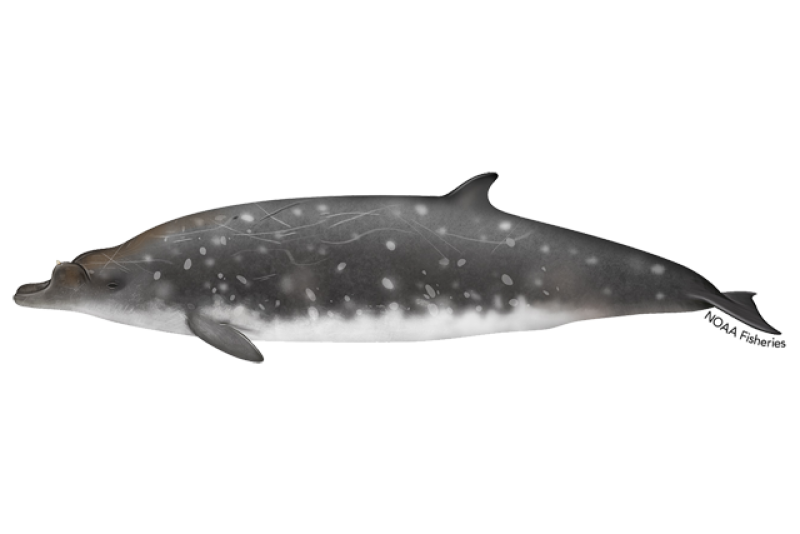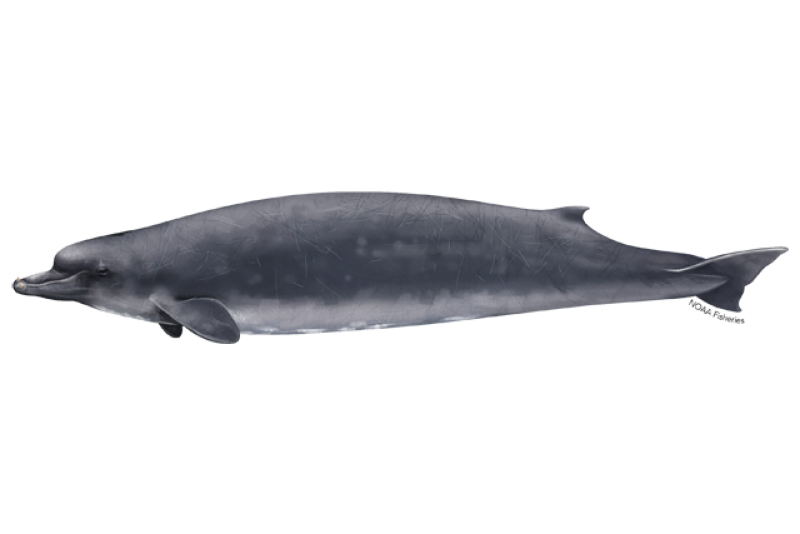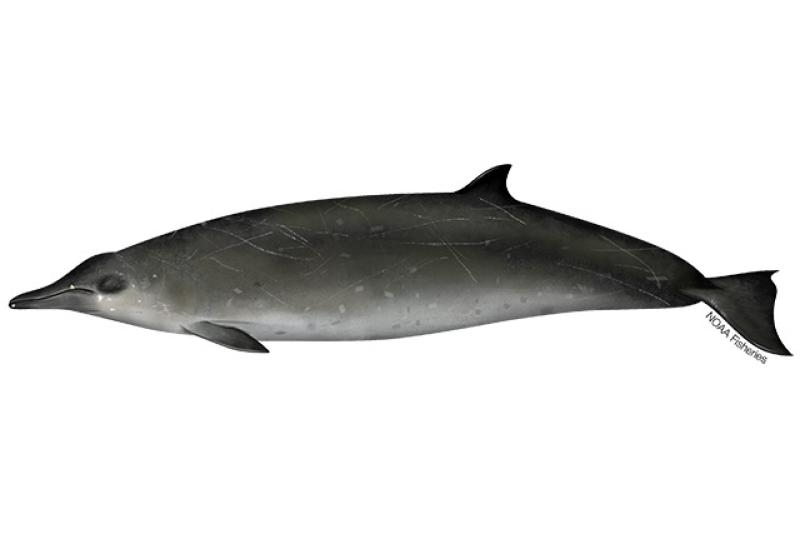Gervais' Beaked Whale
Mesoplodon europaeus
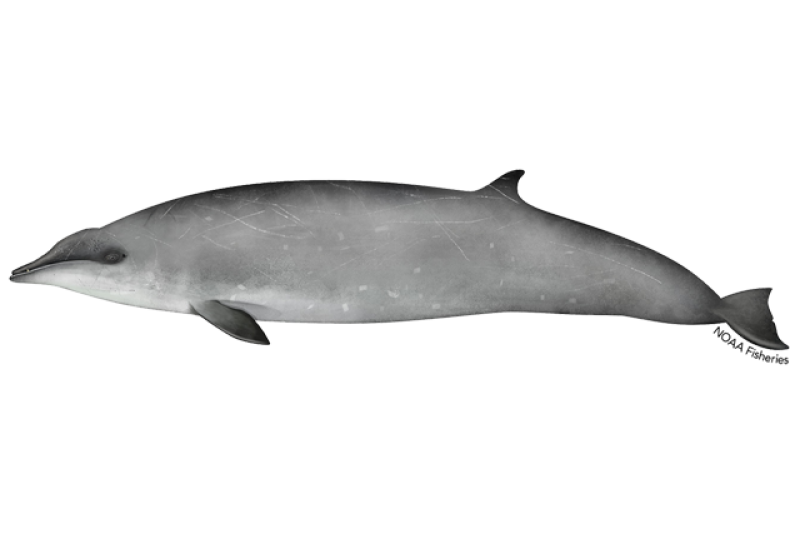
Protected Status
Quick Facts
 Gervais' beaked whale. Credit: NOAA Fisheries
Gervais' beaked whale. Credit: NOAA Fisheries
Gervais' beaked whale. Credit: NOAA Fisheries
About the Species
 Gervais' beaked whale. Credit: NOAA Fisheries
Gervais' beaked whale. Credit: NOAA Fisheries
Gervais' beaked whale. Credit: NOAA Fisheries
Gervais’ beaked whales are little known members of the beaked whale family, Ziphiidae. Sometimes called the "Antillean" or "Gulf Stream beaked whale," this species prefers deep tropical, subtropical, and warm temperate waters of the Atlantic Ocean but is occasionally found in colder temperate seas.
There is little information on the abundance of Gervais’ beaked whales worldwide, though they may be the most commonly sighted species of the Mesoplodon genus off the U.S. Atlantic coast and the Gulf of America (formerly Gulf of Mexico). They are also the most common Mesoplodon species to strand on the U.S. southeastern Atlantic coast. The beaked whale family is cryptic and skittish, and distinguishing between species in the field can be challenging.
Like all marine mammals, Gervais’ beaked whales are protected under the Marine Mammal Protection Act. They face threats from entanglement in fishing gear and human-caused noise. Gervais’ beaked whales are considered “data deficient” by the International Union for Conservation of Nature list of threatened species, meaning that there is not enough information to assess their population status.
Population Status
NOAA Fisheries estimates population size for each stock of Gervais’ beaked whale in its stock assessment reports. A stock is a group of animals that occupy the same area and interbreed. There are insufficient data to determine the population trends for this species.
Appearance
Even when dead, many species of beaked whales, especially those in the genus Mesoplodon that includes Gervais’ beaked whales, are very difficult to distinguish from one another because they lack easily discernible or apparent physical characteristics.
As adults, Gervais' beaked whales can reach lengths of about 15 to 17 feet and weigh at least 2,640 pounds. Females may be slightly larger than males. Mature males can be distinguished from females and juveniles by a pair of visible teeth that erupt from the front portion of their bottom jaw. Females and juveniles also have teeth, but they remain hidden beneath the mouth’s gum tissue. Gervais beaked whales typically have straight or slightly curved jawlines.
Gervais' beaked whales have a relatively small to medium-size body with a moderately long beak and an indistinct sloping forehead (or melon). They have a small, triangular, wide-based, slightly hooked dorsal fin located far down the back. Their coloring is dark gray or bluish to black, with a paler ventral side. They tend to become darker as they age. Both females and males often have a pronounced dark patch around the eye. Females and young males may have a series of small, faint, wavy stripes down the centerline of the back. Mature males may also have linear scars from battles over females; however, scarring is generally not heavy with this species.
Behavior and Diet
At sea, Gervais’ beaked whales are challenging to observe and identify to the species level because of their cryptic, skittish behavior; low profile; and a small, inconspicuous blow at the water’s surface. Therefore, much of the available characterization for beaked whales is to the genus level only.
Gervais' beaked whales are usually found individually or in small closely associated social groups. While diving, they use suction to feed mainly on cephalopods (e.g., squid), mysid shrimp, and small fish in deep water.
Lifespan & Reproduction
The estimated lifespan of this species is at least 27 years but may be up to 48 years. Females may become sexually mature at 15 feet. A sexually mature female will give birth to a single newborn calf that is about 7 feet long and weighs about 176 pounds.
Threats
Entanglement in Fishing Gear
Gervais' beaked whales have been incidentally taken as bycatch in fishing gear, such as pound nets off the U.S. Atlantic coast (e.g., New Jersey) and potentially in driftnets and gillnets.
Hunting
This species may be captured in the Caribbean Sea for food.
Ocean Noise
Deep-diving cetaceans like Gervais’ beaked whales use sound to feed, communicate, and navigate in the ocean. This species may be sensitive to underwater sounds and man-made noise. Sound pollution threatens them by interrupting their normal behavior and driving them away from areas important to their survival, such as feeding and breeding waters.
Scientific Classification
| Kingdom | Animalia | Phylum | Chordata | Class | Mammalia | Order | Cetacea | Family | Ziphiidae | Genus | Mesoplodon | Species | europaeus |
|---|
Last updated by NOAA Fisheries on 06/23/2025
What We Do
Conservation & Management
All Gervais’ beaked whales are protected under the MMPA. Our work protects this species by:
- Reducing interactions with commercial and recreational fishing gear
- Implementing requirements to reduce serious injuries and mortalities
- Minimizing the effects of vessel disturbance, noise, and other types of human impacts
Science
Our research projects have helped us better understand Gervais’ beaked whales and the challenges they face. Our work includes:
- Stock assessments
- Acoustic monitoring
How You Can Help
Keep Your Distance
Be responsible when viewing marine life in the wild. Observe all large whales from a safe distance of at least 100 yards and limit your time spent observing to 30 minutes or less.
Report Marine Life in Distress
Report a sick, injured, entangled, stranded, or dead animal to make sure professional responders and scientists know about it and can take appropriate action. Numerous organizations around the country are trained and ready to respond. Never approach or try to save an injured or entangled animal yourself—it can be dangerous to both the animal and you.
Learn who you should contact when you encounter a stranded or injured marine animal
Report a Violation
Call the NOAA Fisheries Enforcement Hotline at (800) 853-1964 to report a federal marine resource violation. This hotline is available 24 hours a day, 7 days a week for anyone in the United States.
You may also contact your closest NOAA Office of Law Enforcement field office during regular business hours.
Featured News

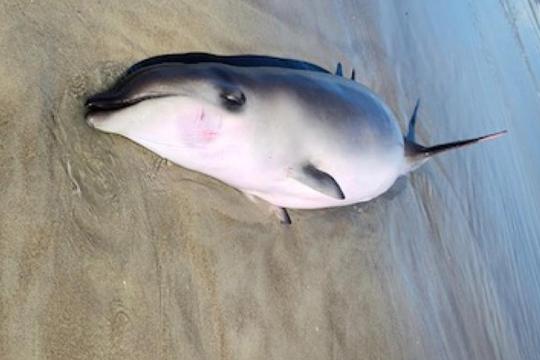 Gervais’ beaked whale on the beach at Emerald Isle in North Carolina. Credit: NOAA Fisheries
Gervais’ beaked whale on the beach at Emerald Isle in North Carolina. Credit: NOAA Fisheries
 Rice's Whale. Credit: NOAA Fisheries
Rice's Whale. Credit: NOAA Fisheries
Protecting Species While Planning for Offshore Wind Development in the U.S. Gulf of Mexico
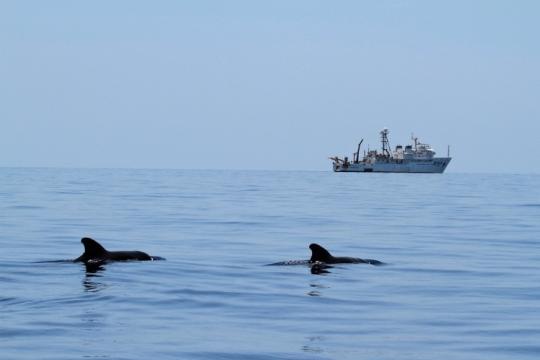 Pilot whales surface near the NOAA Ship Gordon Gunter. Credit: NOAA Fisheries/Melody Baran (Permit # 14450)
Pilot whales surface near the NOAA Ship Gordon Gunter. Credit: NOAA Fisheries/Melody Baran (Permit # 14450)
Management Overview
The Gervais' beaked whale is protected throughout its range under the Marine Mammal Protection Act.
Additionally, the Gervais' beaked whale is listed under:
- Appendix II of the Convention on International Trade in Endangered Species of Wild Fauna and Flora (CITES)
- Annex II of the Protocol for Specially Protected Areas and Wildlife (SPAW)
Conservation Efforts
Reducing Interactions with Fishing Gear
Gervais’ beaked whales are caught as bycatch in fishing gear, leading to deaths and serious injuries, such as in pound nets off the U.S. Atlantic coast, leading to deaths and serious injuries. NOAA Fisheries is committed to minimizing bycatch in U.S. fisheries to ensure populations are sustainable and to protect species such as the Gervais’ beaked whale.
Learn more about bycatch and fisheries interactions
Overseeing Marine Mammal Health and Stranding Response
We work with volunteer networks in all coastal states to respond to marine mammal strandings including all whales. When stranded animals are found alive, NOAA Fisheries and our partners assess the animal’s health and determine the best course of action. When stranded animals are found dead, our scientists work to understand and investigate the cause of death. Although the cause often remains unknown, scientists can sometimes attribute strandings to disease, harmful algal blooms, vessel strikes, fishing gear entanglements, pollution exposure, and underwater noise. Some strandings can serve as indicators of ocean health, giving insight into larger environmental issues that may also have implications for human health and welfare.
Learn more about the Marine Mammal Health and Stranding Response Program
Marine Mammal Unusual Mortality Events
Gervais’ beaked whales have never been part of a declared unusual mortality event. Under the Marine Mammal Protection Act, an unusual mortality event is defined as "a stranding that is unexpected; involves a significant die-off of any marine mammal population; and demands immediate response." To understand the health of marine mammal populations, scientists study unusual mortality events.
Get information on active and past UMEs
Get an overview of marine mammal UMEs
Addressing Ocean Noise
NOAA Fisheries is investigating all aspects of acoustic communication and hearing in marine animals, as well as the effects of sound on beaked whale behavior and hearing. For example, the use of at least some types of shipboard echosounders decreases the acoustic detection rates of multiple species of beaked whales, indicating that they change their behavior when they hear these echosounders. In 2016, we issued technical guidance for assessing the effects of anthropogenic sound on marine mammal hearing.
Regulatory History
Like all marine mammals, Gervais’ beaked whales are protected under the MMPA.
Key Actions and Documents
More Information
Last updated by NOAA Fisheries on 06/23/2025
Science Overview
NOAA Fisheries conducts a variety of research on the biology, behavior, and ecology of Gervais’ beaked whales. The results of this research are used to inform management decisions and enhance protection efforts for this species.
Stock Assessments
Determining the size of Gervais’ beaked whale populations helps resource managers gauge the success of NOAA Fisheries’ conservation measures. Our scientists collect and present these data in annual stock assessment reports.
Shipboard Studies
NOAA Fisheries conducts research cruises to collect information on beaked whale stocks, such as habit preferences and feeding ecology. Information from this research can be used in management actions to protect these animals.
Acoustic Science
Our research is also focused on acoustics—using underwater sound to learn more about species. We study the basic acoustic behavior of cetaceans and fish, mapping the acoustic environment and finding better ways to study cetaceans using passive acoustic technologies. For example, we tow arrays of hydrophones behind ships to acoustically detect and locate Gervais’ beaked whales during surveys. Using this technology, the Northeast Fisheries Science Center conducted a passive acoustic study to document dive depths of beaked whales, some of which may have been Gervais’ beaked whales. We also use archival bottom-mounted recorders to monitor long-term occurrence of the species at specific recording sites. Our acoustic research also assesses the degree to which human-caused activities are changing the underwater soundscape, how these changes may potentially impact marine animals in their acoustic habitat, and what measures can be taken to mitigate these potential impacts.
Last updated by NOAA Fisheries on 06/23/2025
Data & Maps
Passive Acoustic Cetacean Map
This mapping tool shows when and where specific whale, dolphin, and other cetacean species were…
Research
Killer Whale and Beaked Whale Posters
Art-Science Collaboration Celebrates the Diversity of Killer Whales and Beaked Whales from Around the World
Passive Acoustic Research at the Southeast Fisheries Science Center
The Passive Acoustic Ecology Program conducts research projects that use passive acoustics to assess populations and improve our understanding of cetaceans in the Gulf of America and U.S. waters of the Western Atlantic.
Passive Acoustic Technologies Used at the Southeast Fisheries Science Center
Researchers use advanced technology to record and study the sounds produced by marine mammals and human-made sources.
Passive Acoustics Research Group News & Media
Our Passive Acoustics Research Group frequently makes the news. This page links to articles and other media featuring our staff and their research.
Last updated by NOAA Fisheries on 06/23/2025
